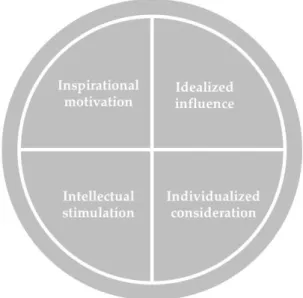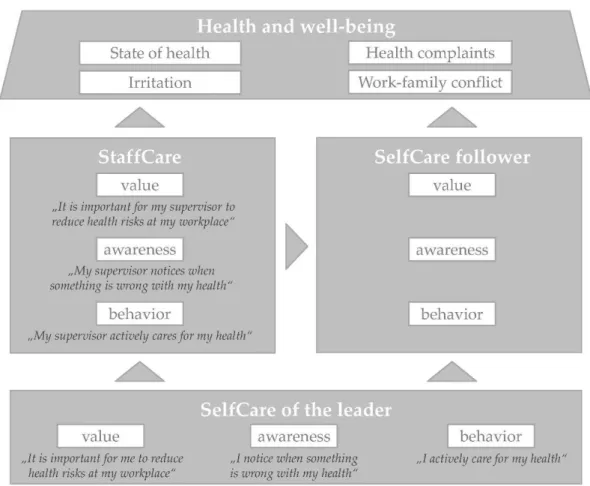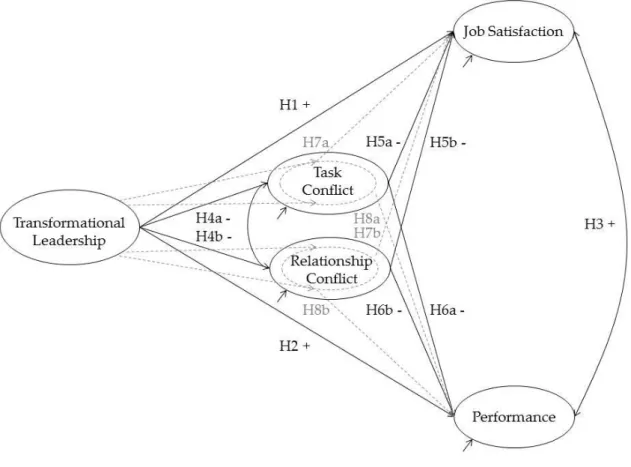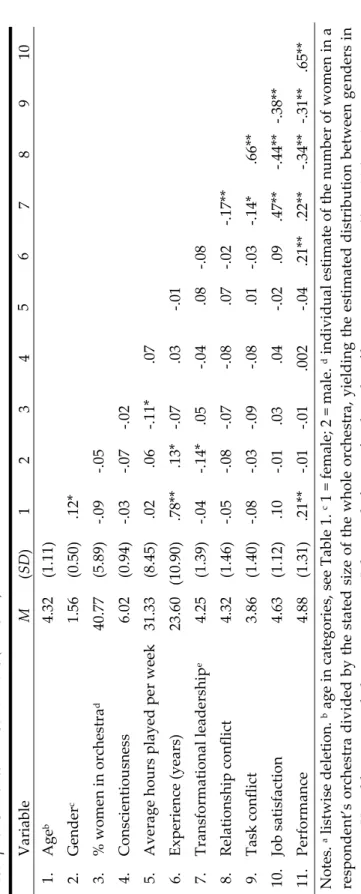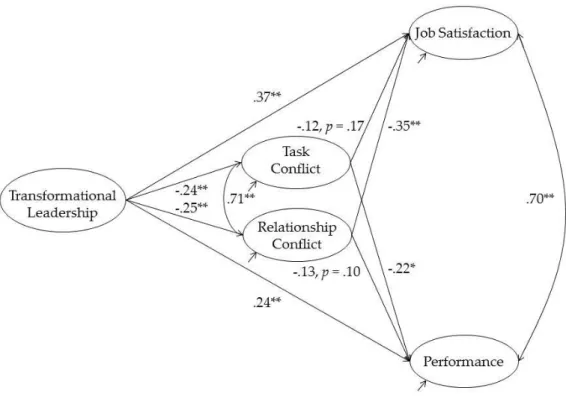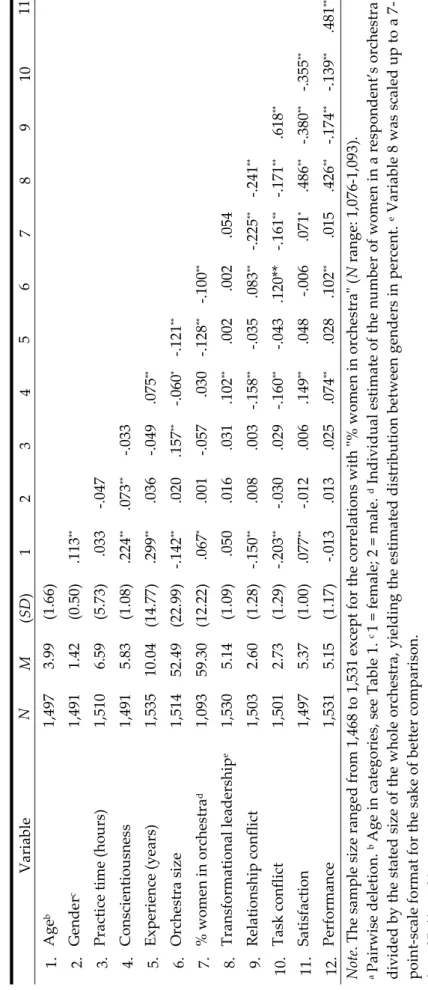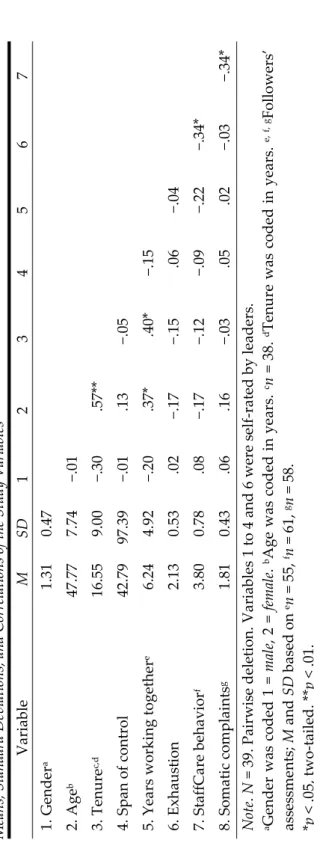An Investigation of Relations between Leadership Behavior and Followers’ Satisfaction, Health, and Performance
in Paid Work and Volunteer Work Contexts
Inaugural-Dissertation
in der Fakultät Humanwissenschaften der Otto-Friedrich-Universität Bamberg
vorgelegt von
Dipl.-Psych. Jana Kammerhoff aus Hannover
Hannover, den 02. September 2019
Dekan: Universitätsprofessor Dr. Jörg Wolstein Betreuerin: Universitätsprofessorin Dr. Astrid Schütz Weiterer Gutachter: Universitätsprofessor Dr. Jörg Wolstein
URN: urn:nbn:de:bvb:473-irb-470386
DOI: https://doi.org/10.20378/irb-47038
ACKNOWLEDGMENTS
I would like to thank my supervisor, Astrid Schütz, for many insightful conversations and her continued support throughout this whole process.
I also want to thank my colleagues at the Department of Personality Psychology and Psychological Assessment in Bamberg for all the fruitful discussions, the free exchange of ideas and a great working environment.
In addition, I would like to thank the examination committee of this dissertation - Astrid Schütz, Jörg Wolstein, Julia Franz, and Stefan Lautenbacher - as well as the anonymous reviewers of the included manuscripts. Also, I would like to thank Iris Katharina Koch, Matthias Stadler, and Nida Bajwa for their constructive feedback on previous versions of the manuscript as well as Lindie van der Westhuizen for proofreading. Special thanks go to my colleague Christina Köppe for inviting me to co- author one of the included articles.
Finally, this work would not have been possible without the support and
encouragement of my family and friends. I thank you all!
PREAMBLE
This work is written as a publication-based dissertation consisting of three peer- reviewed and internationally published articles that are embedded in the text. Although the formats of the articles were adapted to fit the format of the dissertation, their content remains unchanged. The articles included are:
Kammerhoff, J., Lauenstein, O., & Schütz, A. (2019). Leading toward harmony – Different types of conflict mediate how followers’ perceptions of transformational leadership are related to job satisfaction and performance.
European Management Journal, 37(2), 210–221.
https://doi.org/10.1016/j.emj.2018.06.003.……...27
Kammerhoff, J., Lauenstein, O., & Schütz, A. (2019). Tuning into performance and satisfaction in nonprofit orchestras: One link between transformational leadership and satisfaction is through reduction in conflict. Nonprofit Management and Leadership, 30(2), 321-338. https://doi.org/10.1002/nml.21381...61
Köppe, C., Kammerhoff, J., & Schütz, A. (2018). Leader-follower crossover: exhaustion
predicts somatic complaints via Staffcare behavior. Journal of Managerial
Psychology, 33(3), 297-310. https://doi.org/10.1108/JMP-10-2017-0367...95
SUMMARY
Twenty-first century work is characterized by change in working conditions and increased job demands. An increase in job demands heightens the need for leadership to serve as a resource to followers in both volunteer and paid work contexts. Focusing on leadership and followers’ experience, this dissertation consists of three articles that aim to identify antecedents that are relevant to the well-being and performance of individuals. This is achieved by concentrating on followers’ job satisfaction, health, and performance to describe their experience and by focusing on transformational leadership and health-oriented leadership while taking leaders’ health into account. The goal of this work is to advance our understanding of how leaders’ behavior is related to their followers’ experience and to thereby encourage useful leadership behavior. This is likely to improve the experience for leaders’ and followers’ alike and, consequently, result in leaders serving as a true resource to their followers.
All three articles have been published in international, peer-reviewed journals.
The first two articles center on transformational leadership behavior and demonstrate its relations with job satisfaction and performance in the workplace. Although both samples consist of active musicians in orchestras, Article 1 made use of a professional sample, while Article 2 used a volunteer sample. The data were collected via questionnaires.
Task and relationship conflicts were included as mediators for both samples. More specifically, in the professional sample, task conflict mediated the relation between transformational leadership and performance, while relationship conflict mediated the relation between transformational leadership and job satisfaction. In contrast, for the volunteer sample, both task and relationship conflict mediated the relation between transformational leadership with job satisfaction, but not between transformational leadership and performance.
The third article is concerned with leader and follower health. Followers’ health
was operationalized as self-reported somatic complaints, whereas leaders’ health was
operationalized as self-reported level of exhaustion. The sample included leaders from
various paid work contexts (e.g., IT, human resources, sales, administration) and one to
two of their followers. Measurement occurred over two waves, with three months
between waves. The study revealed a negative relation between health-oriented
leadership behavior and followers’ somatic complaints. In addition, it also showed the
existence of an indirect crossover effect from leaders’ level of exhaustion to followers’
health via a reduction in health-oriented leadership behavior when the exhaustion level was high.
Overall, the findings of the three articles demonstrate the importance of both transformational and health-oriented leadership behavior in shaping followers’
experience. This underscores the potential value of encouraging such leadership
behaviors - in both paid work and volunteer work contexts - in order to improve leader
and follower well-being and performance. Importantly, the findings also suggest that
leaders’ ill health should be addressed not just for their own benefit, but due to the fact
that leader exhaustion can negatively impact their followers’ health (albeit indirectly)
through a crossover process.
TABLE OF CONTENTS
ACKNOWLEDGMENTS ... III PREAMBLE ... V SUMMARY ... VII TABLE OF CONTENTS ... IX
INTRODUCTION ... 1
GENERAL THEORETICAL BACKGROUND ... 5
JOB SATISFACTION ... 6
HEALTH ... 8
PERFORMANCE ... 9
DRIVERS OF JOB SATISFACTION, HEALTH, AND PERFORMANCE ... 10
LEADERSHIP ... 11
EMPIRICAL WORK ... 17
INTRODUCTION TO ARTICLES 1 AND 2 ... 19
ARTICLE 1: LEADING TOWARD HARMONY: DIFFERENT TYPES OF CONFLICT MEDIATE HOW FOLLOWERS’ PERCEPTIONS OF TRANSFORMATIONAL LEADERSHIP ARE RELATED TO JOB SATISFACTION AND PERFORMANCE ... 27
ARTICLE 2: TUNING INTO PERFORMANCE AND SATISFACTION IN NONPROFIT ORCHESTRAS: ONE LINK BETWEEN TRANSFORMATIONAL LEADERSHIP AND SATISFACTION IS THROUGH REDUCTION IN CONFLICT ... 61
CRITIQUE ... 88
INTRODUCTION TO ARTICLE 3 ... 92
ARTICLE 3: LEADER-FOLLOWER CROSSOVER: EXHAUSTION PREDICTS SOMATIC COMPLAINTS VIA STAFFCARE BEHAVIOR ... 95
CRITIQUE ... 120
GENERAL DISCUSSION ... 123
SUMMARY OF THE RESULTS ... 125
THEORETICAL IMPLICATIONS ... 126
PRACTICAL IMPLICATIONS ... 130
LIMITATIONS AND IMPLICATIONS FOR FUTURE RESEARCH ... 132
CONCLUSION ... 134
REFERENCES ... 136
APPENDIX ... 147
1
INTRODUCTION
Be happy! Be healthy! Be productive!
For the last few years, the pursuit of happiness, health, and productivity have become topics of great interest to the general public. This is reflected in the omnipresence of self-help books, articles, blogs, and websites claiming to have found the best way of being happy, healthy and productive. Easy answers with anecdotal evidence are prevalent, for example, “green vegetables could help you to live longer” (Atherton, 2018). If you do x, you will be an improved version of yourself and you will be satisfied.
It is an attractive concept: An if-then relationship that makes life understandable, even controllable. However, life is multi-faceted and can be hectic, ambiguous and complicated. The feeling of having insufficient time to accomplish goals can reduce well- being (Gärling, Gamble, Fors, & Hjerm, 2016), and role ambiguity and difficult social interactions (e.g., interpersonal conflicts) are related to negative emotions (Spector, Chen, & O’Connell, 2000). Recent developments concerning the so-called “digital revolution” (or fourth industrial revolution, Schwab, 2017) have led to shifting requirements on people’s lives - in both paid work and volunteer work contexts - that have resulted in condensed workflows, faster communication and near constant availability, all of which can be demanding (Albers, 2018; Matusiewicz, 2019; Weiß &
Wagner, 2017). There are no quick fixes for individuals to simply arrive at being happy, healthy and productive - much is still unknown. The current dissertation, therefore, aims at broadening the understanding of the antecedents of happiness, health and productivity by addressing the question, “what are the factors that influence a person’s physical and psychological well-being as well as their performance?”
Research on the job demands-resources model shows that demands (i.e., “aspects of the job that require sustained physical or mental effort”, Demerouti, Bakker, Nachreiner, & Schaufeli, 2001a, p. 501) are detrimental to mental and physical well-being and performance, whereas resources (i.e., “physical, psychological, social, or organizational aspects of the job that may do any of the following: (a) be functional in achieving work goals; (b) reduce job demands at the associated physiological and psychological costs; (c) stimulate personal growth and development”, Demerouti et al., 2001a, p. 501) have positive effects on well-being and performance (Bakker & Demerouti, 2017). Studies show job demands can lead to a decline in health, anxiety, reduced job satisfaction, and exhaustion (Bakker, Demerouti, & Verbeke, 2004; Hakanen, Schaufeli, &
Ahola, 2008; Spector et al., 2000). Exhaustion diminishes performance and facilitates
burnout, whereas resources induce and increase motivation and engagement, and can even buffer the negative effects of various job demands (Bakker & Demerouti, 2017;
Demerouti, Bakker, Nachreiner, & Schaufeli, 2001b; Halbesleben & Wheeler, 2011).
The relationship between a leader and follower is central to an individual’s experience of work. It is therefore not surprising that leadership has been shown to play an important role in followers’ demands and resources (Breevaart & Bakker, 2018).
Leaders can shape the work experience of followers’ through the assignment of tasks, their behavior toward their followers (e.g., appreciative, aggressive), and their consideration for their own and their followers’ health. They can directly influence some, though not all, demands that put strain on their followers. Leadership behavior can, however, also serve as a resource to their followers, for example, through the provision of support and the creation of development opportunities (Bakker & Demerouti, 2017).
The leader-follower relationship is, however, not unique to the for-pay work environment. It is also an important factor for many unpaid activities (for example, in volunteer settings, in hobby and special interest groups, or in sports) as these also often rely on hierarchical structures (e.g., chairpersons, coaches, instructors).
Given the centrality of leadership to followers’ experience, this dissertation aims to add to the literature on leadership behavior and its relation to followers‘ job satisfaction, health, and performance. Advancing knowledge in this area could, ultimately, inform interventions that can facilitate improvements in individual well- being and performance in both paid work and unpaid settings. However, the question remains: How exactly does leadership behavior relate to positive outcomes for followers and for the organization?
The present work contains three articles that aim to address this question. The first two articles addressed leadership behavior and its relations to job satisfaction and performance in paid work (Article 1) and in volunteer work contexts (Article 2). Both articles considered task conflict and relationship conflict, a common stressor at work.
The third article addressed leadership behavior and its relation with followers’ somatic
complaints. More specifically, it addressed specific leadership behaviors involving care
for followers’, while also taking leaders’ level of exhaustion into account. The three
articles aim to advance the literature on the relation between leaders’ behavior and
followers’ experience in order to ultimately improve leaders’ and followers’ experience
through reduced demands and increased resources.
The dissertation is structured as follows: The subsequent section provides an
overview of the General Theoretical Background for the three included articles. Thereafter,
the Empirical Work section presents each of the three articles with an accompanying
introduction, the original publication, and a short critique. Finally, the General Discussion
section addresses the theoretical and practical implications as well as limitations and
possible directions for future research.
2
GENERAL THEORETICAL BACKGROUND
The satisfaction people derive from tasks that they do - be it in their free time or at work - is a positive outcome in and of itself. This type of satisfaction is also related to several other desirable outcomes, such as general life satisfaction, organizational affective commitment, performance and health (Eby, Freeman, Rush, & Lance, 1999;
Faragher, Cass, & Cooper, 2005; Judge, Thoresen, Bono, & Patton, 2001; Judge &
Watanabe, 1993). Good health facilitates improved performance and is an important component of quality of life (Grawitch, Waldrop, Erb, Werth, & Guarino, 2017).
Performance, in the sense of goal attainment, has been shown to be related to happiness (McGregor & Little, 1998). Job satisfaction, health, and performance are thus all desirable outcomes. Research on the antecedents of these outcomes is important as they could lead to improved experiences for people in both paid work and volunteer work contexts and also be beneficial to organizations.
The overarching research question of this dissertation is: How do transformational leadership behavior and health-related leadership behavior function as a resource to followers and, more specifically, how do they relate to followers’ job satisfaction, health, and performance? These constructs, consequently, require clarification. The following section defines and describes job satisfaction, health and performance in paid work and volunteer work contexts. Thereafter, leadership and its relation to the three aforementioned constructs are discussed. More specifically, the discussion focuses on transformational leadership behavior (i.e. leading by uplifting followers’ morale and motivation, Bass, 1999) and health-related leadership behavior (i.e.
caring about followers’ health, Franke & Felfe, 2011) as antecedents of followers’ job satisfaction, health, and performance.
Job Satisfaction
The importance and centrality of job satisfaction in organizational psychology is evident by the plethora of publications on the subject in the last few decades (Locke, 1969; Wright, 2006). In organizational psychology, job satisfaction is generally considered to be an attitude and is commonly defined using Locke’s (1969) definition:
“Job satisfaction is the pleasurable emotional state resulting from the
appraisal of one's job as achieving or facilitating the achievement of one's
job values. […] Job satisfaction and dissatisfaction are a function of the perceived
relationship between what one wants from one's job and what one perceives it as
offering or entailing [emphasis in original].” (Locke, 1969, p. 316).
A state of job satisfaction is thus reached when personal criteria are met or surpassed. People’s job needs and expectations (for instance, the need to belong, the need for cognition, the need for security, and the standard of living that one is accustomed to) lead to different criteria. Alternatively stated, different things have different value to different people. Some people value high monetary compensation and are satisfied when this criterion is met, while others value social connections with their colleagues more.
The level of job satisfaction achieved is the outcome of a cognitive process assessing the extent to which personal standards are being fulfilled (Diener, Emmons, Larsen, & Griffin, 1985) and thus differs inter-individually. One person may be more comfortable with routine tasks, whereas another may seek more varied and challenging tasks. If both perform monotone tasks, their individual level of job satisfaction will differ.
This dissertation focuses on job satisfaction due to its inherent value to individuals as well as its relevance to the effective functioning of organizations.
Considering the individual, higher job satisfaction influences positive moods outside of the job (Judge & Ilies, 2004) and is related to life satisfaction (Judge & Watanabe, 1993).
In addition, higher levels of job satisfaction are desirable to organizations due to the relations with many relevant outcomes such as turnover intentions (Coomber & Louise Barriball, 2007; Tett & Meyer, 1993; Zito et al., 2018), organizational commitment (Top, Akdere, & Tarcan, 2015; Yousef, 2017) and performance (Judge et al., 2001; Whitman, Van Rooy, & Viswesvaran, 2010).
According to the job demands-resources model both job demands and resources influence a person’s well-being (Bakker & Demerouti, 2017; Demerouti & Bakker, 2007;
Demerouti et al., 2001b). Well-being is a broad concept that considers the individual in their entirety, that is, it includes both physiological well-being and psychological well- being. Job satisfaction is a commonly used measure of well-being in the workplace (Danna & Griffin, 1999) and is related to the characteristics of a job, its’ demands, and resources (Judge, Bono, & Locke, 2000; Urien, Osca, & García-Salmones, 2017; Zito et al., 2018).
Articles 1 and 2 investigate the relations between job satisfaction, conflicts (as an
example of a demand), and transformational leadership in paid work and volunteer
work contexts. More specifically, the role of transformational leadership is investigated as a potential means to alleviate conflict (i.e. demands) at work in these two contexts.
Health
The term well-being is used to describe the evaluations people make concerning their bodies and minds, the circumstances of their lives and the events they experience (Diener, 2006). Satisfaction is an important component of well-being (Diener, 1984, 2006) and so is health (Danna & Griffin, 1999). The World Health Organizations defines health as follows:
“Health is a state of complete physical, mental and social well-being and not merely the absence of disease or infirmity” (WHO, 2018, p. 100).
Health is inherently valuable and is associated with important benefits, such as higher quality of life. A representative survey in Germany in 2010 found that health is deemed to be the most important aspect of life (Hinz, Hübscher, Brähler, & Berth, 2010).
Health does not only have inherent personal benefits for the individual; it also impacts organizations through the level of performance of its individual members.
While health is a factor than enables performance, health problems are related to decreased performance and productivity (Grawitch et al., 2017; Meerding, IJzelenberg, Koopmanschap, Severens, & Burdorf, 2005; Miraglia & Johns, 2016).
Organizations (as entities) thus have a vested interest in the health of their members as they rely on their members to perform well. Organizations, consequently, plan, implement or change the work environment in a manner that leads to improvements for employees (Burke & Richardsen, 2014; Rongen, 2015; Taris et al., 2003). For example, contextual factors such as health and safety equipment, regulations, and related training, and awareness-campaigns are often provided. Leaders also shape their followers’ work environment through, for example, instruction, training and the provision of resources. They play a crucial role in maintaining and/or improving followers’ well-being.
Within the job demands-resources framework, health is influenced by high job demands, however, a person’s resources can buffer the negative effects thereof. Health can be a resource in itself as well as a buffer (Bakker & Demerouti, 2017; Demerouti &
Bakker, 2007; Demerouti et al., 2001b). For instance, a job with a high level of time
pressure and parallel tasks can induce stress and facilitate health problems. However,
the support of one’s leader can be a resource and can increase resilience to stress and avoid harm toward one’s health. Health, as a resource, can, for example, manifest as being physically fit. Physical fitness would be helpful when facing physical demands (e.g. heavy lifting) and will result in higher capabilities to perform the task.
In this dissertation, health was studied in two ways (Article 3): as an outcome and as a resource. With regard to the former, health was operationalized as the extent to which one suffers from somatic complaints. With regard to the latter, health was operationalized as exhaustion - encompassing physical as well as mental components.
More specifically, the definition of exhaustion by Demerouti et al. (2001) was used.
Demerouti and colleagues described exhaustion as a state that results from intense strain on a physical, affective and cognitive level. Although exhaustion decreases people’s capabilities, leadership behavior can act as an important resource to followers to diminish its effects. Consequently, Article 3 investigated leaders’ level of exhaustion in relation to their behavior toward their employees’ and to employees’ level of somatic complaints.
Performance
The term performance is commonly used in day-to-day conversations, in academic, and work contexts.
“There are as many kinds of performance as there are occasions for performance.” (Landy, Zedeck, & Cleveland, 2017, p. 1)
In this dissertation Baumgarten’s (1977) definition is used. He defines performance as a parameter that describes the extent to which any given individual succeeds in performing their function within the greater scope of the organization.
In the context of this work, performing one’s function means engaging in behavior that contributes toward the achievement of an overarching goal that lies within the greater scope of the organization. This goal is set by a person in a leadership position who is legitimized through the organizational structure of the organization. Although the goal is set by the leader and not by the individual, both parties (leader and follower) are part of it.
Performance is in itself a neutral term that needs qualifiers to indicate the
direction, for example, high or low levels of performance. High levels of performance
could result in the achievement of the goal to its fullest extent or even going above-and-
beyond. A high level of performance toward an organizational goal is desirable for the organization and, if the organizational goal is one that the individual subscribes to, is desirable for the individual as well. The attainments of such goals are related to feelings of happiness (McGregor & Little, 1998).
In the job demands-resources model performance is influenced by a person’s well-being and motivation which, in turn, are influenced by job demands and resources (Bakker & Demerouti, 2017).
Article 1 and 2 investigated the relation of performance with transformational leadership in paid work and volunteer work contexts. More specifically, it was investigated whether leadership can act as a resource to followers via leaders’
transformational behavior while also considering the potential impact of conflicts (as an example of a job demand.
Drivers of Job Satisfaction, Health, and Performance
Job satisfaction is driven by internal and external factors. For example, core self- evaluations (consisting of self-esteem, self-efficacy, low neuroticism, and locus of control) have been identified as important internal factors, while job characteristics (e.g., job complexity) have been identified as important external factors (Judge et al., 2000;
Loher, Noe, Moeller, & Fitzgerald, 1985). By changing certain job characteristics, for example, enriching less varied tasks, leaders can influence job satisfaction indirectly (Millette & Gagné, 2008). However, the impact of leadership on job satisfaction can also be more direct. The support provided by leaders (i.e. supervisor support) plays a role in the extent to which a person is satisfied with their job (Alegre, Mas-Machuca, &
Berbegal-Mirabent, 2016).
Health is influenced by individual biological factors (e.g., the aging process, genetic make-up) and environmental factors (e.g., air pollution), as well as the interaction between the two. The act of constantly performing physically strenuous tasks will increase the risk of deterioration of health, although this depends on the strength and general state of health of the individual (Burr, Pohrt, Rugulies, Holtermann, &
Hasselhorn, 2017; Parkes, 2006). Similarly, working in stress inducing environments will
increase the risks to one’s health. Several job demands can be stress-inducing, for
instance, continuous background noise (Ising & Kruppa, 2004) or ambiguous roles at
work can negatively impact well-being and performance (Jackson & Schuler, 1985).
Leaders can partly influence many aspects of tasks and, consequently, their followers’
experience by, for example, removing uncertainty concerning responsibilities and roles.
Individual performance can be impacted through different pathways which can either facilitate or obstruct performance. Some of these pathways are within the individual themselves (e.g., skills, knowledge, and motivation). Other pathways are external to the individual (e.g., the availability of suitable resources). In an organizational context, leaders can act as the linchpin in providing the suitable resources. More specifically, leaders can determine the amount of time that can be spent on a task or provide the training and learning opportunities needed to increase followers’ knowledge and skills (Baumgarten, 1977; DiGirolamo & Tkach, 2019). In addition, leaders can influence job demands (e.g., through the assignment of tasks, by adjusting workload, or by adjusting time schedules). By influencing the resources available to followers and the demands placed on them, leaders can significantly impact follower motivation and, ultimately, their job satisfaction, health and performance.
In general, aspects of a job that require continuous effort (i.e. impose demands on the individual), have detrimental effects on job satisfaction, health and performance. In contrast, resources have positive relations with job satisfaction, health and performance and can even buffer the impact of some job demands (Bakker & Demerouti, 2017;
Halbesleben & Wheeler, 2011; Spector et al., 2000). Leadership plays an important role in this because leadership behavior itself can be a resource to followers. In addition, the leaders’ behavior toward their followers’ can also potentially buffer negative effects of demands (Bakker & Demerouti, 2017; Vincent, 2012).
Leadership
Having one or more people assume leadership roles is common in both informal
circles (e.g. friendship or hobby groups) and more formal settings (e.g. governments,
national or global corporations, small business, or start-ups). Many organizations have
formalized differentiations in rank. These ranks allow people higher up in the “corporate
ladder” to have more power over people that are lower down in the hierarchy. Leaders
have certain levels of authority within organizations. The authority is bound by the
interests and the framework of the organization as well as governmental regulations and
employee protection regulations.
Leadership involves shaping people’s behavior, meaning, using communication processes to influence people’s behavior in a goal-oriented way (Baumgarten, 1977;
Rosenstiel, 2006). People in leadership positions need to set goals and organize their followers in a manner that facilitates the achievement of these goals. Pinnow (2012) describes leadership as enabling followers to achieve tasks together and to adapt to changes through further training and education as well as through the setting of relevant goals, values, and organizational structures. The process of influencing the behavior of others, entails having the authority for decision-making, implementing the decision and controlling the outcome (Baumgarten, 1977).
Leadership plays an important role in the achievement of goals that are worked on by a group or groups of individuals. Effective leadership enables higher levels of performance by their followers and is often defined as effective because of the higher levels of performance. Efficacious is “having the power to produce a desired effect”.
Therefore, effectiveness can be understood to be the degree to which goals are reached and, in an organizational context, it refers to the degree to which the organizational tasks that lead to the organizational goals are performed (Merriam-Webster Dictionary, 2019a).
Leadership not only involves ensuring followers perform their functions well; it also involves ensuring the right conditions are in place (e.g., by providing information and necessary material, fostering and supporting followers in ways that allow them to perform well).
Different forms of leadership exist. This dissertation focuses on the transformational leadership style and the health-oriented leadership approach. This is due to the fact that several studies have shown that the behaviors associated with these two leadership approaches are positively related to followers’ job satisfaction, health and performance. The study of these leadership approaches has the potential to produce information that can be used to promote effective leadership behavior which, in turn, can support followers’ well-being.
Articles 1 and 2 in this dissertation address transformational leadership, while Article 3 addresses StaffCare behavior, meaning, the behavioral component of the health-oriented leadership approach.
In the following section, I will first describe transformational leadership and
health-oriented leadership. Thereafter, I will present how these leadership behaviors
might influence followers’ job satisfaction, health, and performance within the respective introductions of the articles.
Transformational Leadership
The term transformational leadership was first introduced by J. V. Downton in 1973. J. M. Burns uses transforming leadership to describe a leadership relationship between leaders and followers where both interact in such a way that the interaction results in the achievement of higher levels of morality and motivation for both parties (Burns, 1978).
B. M. Bass based his transformational leadership theory on Burns’ approach and extended it to our current understanding of transformational leadership behavior.
Transformational leadership theory consists of four dimensions: (1) inspirational motivation, (2) idealized influence, (3) intellectual stimulation, and (4) individualized consideration (Avolio, Waldman, & Yammarino, 1991; Bass, 1990, 1999; Bass & Riggio, 2006).
Figure 1. The four „I“s of Transformational Leadership.
(1) Inspirational motivation. The leader develops a vision that is attractive to the followers. This attractive overall goal gives the tasks that are necessary to achieve the vision meaning and purpose. The vision is used to unite the followers and put the group goal into focus, shifting the focus from the individual goals of the followers themselves.
(2) Idealized influence. Modelling desired behavior is an important component
within the transformational leadership framework. It involves showing followers what is
expected of them as well as functioning as a reminder of the expected standard.
Importantly, the latter implies not only holding the followers’ to that standard but also holding the leader to that same standard. This avoids hypocrisy, especially since transformational leadership heavily relies on creating visions with high moral standards and values.
(3) Intellectual stimulation. The goals derived from the leader’s vision are ambitious. The leader, using transformational leadership behavior, invites the followers’
intellectual engagement with the tasks and supports independent thought.
(4) Individualized consideration. This means being attentive to the follower as an individual and acknowledging their uniqueness. The leader may thus recognize the follower’s personal needs. This makes it possible to support the followers’ individual development and utilize their distinctive potential.
Transformational leadership has been shown to have positive effects on followers’ job satisfaction and performance (Braun, Peus, Weisweiler, & Frey, 2013;
Wang, Oh, Courtright, & Colbert, 2011). The following two articles aim to provide insights into the underlying mechanisms through which transformational leadership may lead to higher levels of job satisfaction and higher levels of performance.
Health-oriented leadership
In addition to transformational leadership, I examine the role of health-oriented leadership in followers’ experience. Article 3 is primarily concerned with followers’
health and its antecedents - in particular, its leadership antecedents. Previous research has shown that health-oriented leadership is particularly relevant for followers’ health and well-being (Franke, Felfe, & Pundt, 2014).
In general, leaders play an important role when it comes to the health of their
followers. The allotment of task-related resources, providing performance feedback, and
being appreciated were found to predict followers’ emotional exhaustion, irritability,
and somatic complaints (Vincent, 2012). Leaders have direct and indirect effects on
followers’ health and well-being. Interpersonal behavior can have a direct impact on
followers, for example, being considerate and finding time to listen to their followers
was found to be directly related to followers feeling less stressed (Rowold & Heinitz,
2008). Indirectly leadership can affect health and well-being for instance via shaping of
working characteristics (role clarity, opportunities for development, etc.) which in turn affect followers’ well-being (Nielsen, Randall, Yarker, & Brenner, 2008).
The health-oriented leadership (HoL) approach was developed by F. Franke and J. Felfe (Franke & Felfe, 2011). The approach explicates direct and indirect pathways of how leadership relates to followers’ health. Furthermore, in accordance with Bandura’s social learning theory (Bandura, 1977); Franke and Felfe propose that leaders influence followers by modelling behavior. The authors also suggest that health impaired leaders may influence their followers’ health, for example, via less caring behavior (Franke, Ducki, & Felfe, 2015).
Figure 2. The “house of HoL” (health-oriented leadership).
Adapted from page 142 of Franke, F., Felfe, J., & Pundt, A. (2014). The Impact of Health-Oriented Leadership on Follower Health: Development and Test of a New Instrument Measuring Health- Promoting Leadership. German Journal of Human Resource Management, 28(1–2), 139–161.
Copyright © 2014 by SAGE publications, Ltd. Reprinted by Permission of SAGE publications,
Ltd.
Health-oriented leadership differentiates between values, awareness, and behavior as components of their three “Care” building blocks that keep up the “house of HoL” (Franke et al., 2014, p. 143). Care can be either directed at oneself (i.e., SelfCare) or it can be directed at others (i.e., a leader’s care for their followers or StaffCare).
The health-oriented leadership concept relies on a definition of care that consists of “value”, “awareness” (sometimes alternatively called “mindfulness”) and “behavior”.
Value describes the interest one has in health and how important it is to the person. For StaffCare, this can involve feeling concerned and responsible for one’s own followers’
health. Awareness refers to health awareness or, alternatively stated, recognizing the state of health and knowing the conditions that influence it. For StaffCare, this involves recognizing signs of stress and strain in followers and being conscious of the work- related conditions that impact their stress levels. Behavior refers to all health-relevant actions. For StaffCare, this entails educating followers’ about health and safety regulations, providing necessary resources for a safe working environment, and ensuring followers take breaks and do not engage in excessive overtime, etc. (Franke et al., 2014).
StaffCare Behavior is thus the component of the health-oriented leadership approach that describes follower-directed leadership behavior. StaffCare behavior incorporates actively caring about followers’ health. It should, consequently, make the most directly felt difference to followers’ health. Leadership behavior is crucial to followers’ experience - both in paid work and volunteer work contexts. It may influence satisfaction with tasks, the task performance itself and health.
The following articles were designed to further explore leadership as a potential
resource to followers. Firstly, the articles explore the relation between the leadership
behavior with followers’ experience. Secondly, and more importantly, the articles delve
into the conditions and underlying mechanisms of why transformational leadership or
StaffCare behavior have these effects on followers’ experience.
3
EMPIRICAL WORK
This dissertation includes three articles that examine the relationship between leadership (transformational leadership in Article 1 and 2; health-oriented leadership in Article 3) and followers‘ experiences (job satisfaction and performance in Article 1 and 2;
health in Article 3).
The first two articles investigated a possible mechanism underlying the relation between transformational leadership and job satisfaction and performance across different leadership contexts. Both articles examined the role of conflict as a demand at work. Conflict is divided into task and relationship conflict. Both task and relationship conflict were included as mediators in the relation between transformational leadership and the outcomes (i.e. job satisfaction and performance). The first article was set in a professional context
1, whereas the second article used a large sample of non-professional people who volunteer their time and talent. Article 1 demonstrated that, in a paid work context, transformational leadership is directly related to job satisfaction and to performance. Furthermore, the results showed that task conflict mediates the relation between transformational leadership and performance, whereas relationship conflict mediates the relation between transformational leadership and job satisfaction. Similarly, the second article showed that, in a non-professional volunteer context, transformational leadership was also directly related to job satisfaction and to performance. However, conflict did not mediate the relationship between transformational leadership and performance. Nevertheless, both types of conflict were found to mediate a part of the relation between transformational leadership and job satisfaction.
The third article addressed, firstly, the conditions for leaders to show desirable leadership behavior that is attuned toward their followers’ health problems that is, leaders’ own level of exhaustion. Secondly, it addressed the crossover effects of leaders’
exhaustion on followers’ somatic state (direct crossover) as well as via their StaffCare behavior (indirect crossover). The results showed an indirect crossover effect from leaders’ level of exhaustion via their StaffCare behavior crossing over to followers’
experience of somatic complaints. Contrary to the hypothesis that there will also be a direct effect from leaders’ exhaustion to followers’ somatic complaints, the results showed no such direct effect.
1
